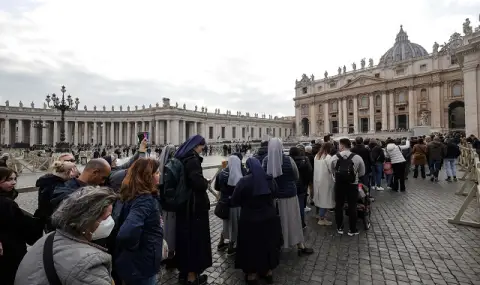With the death of Pope Francis, announced today by the Vatican, the Roman Catholic Church begins a series of traditional rituals marking the end of one papacy and the beginning of a new one, Reuters reports, quoted by BTA.
Most of the rituals are guided by the statute Universi Dominici Gregis (“The Whole Flock of God“), approved by Pope John Paul II in 1996. and revised by Pope Benedict XVI in 2007 and 2013.
A cardinal known as a camerlegno (or camerlegno), currently Irish-American Cardinal Kevin Farrell, will oversee the day-to-day affairs of the nearly 1.4 billion-member Roman Catholic Church during a period known as the “empty see.”
He officially confirms the death of the pope – a simple matter these days, requiring the presence of a doctor and a death certificate. Until the mid-20th century, this was done ritually by tapping the pope's forehead three times with a silver gavel.
The camerlegno and his three assistants, chosen from among the cardinals under the age of 80, known as cardinal electors, decide when the pope's body should be placed in St. Peter's Basilica so that the public can pay their respects.
They also ensure that the pope's "fisherman's ring" and his lead seal are broken so that no one else can use them. No autopsy is performed.
The camerlegno locks and seals the pope's private chambers. In the past, these were the apartments of the Apostolic Palace, but Francis lived in a small apartment in the Vatican guest house “Santa Marta“.
The chamberlains and other cardinals cannot make important decisions that affect the Church or change its doctrines. The heads of most Vatican departments resign until the new pope replaces them or reinstates them in their posts.
The mourning rituals last nine days, with the date of the funeral decided by the cardinals. According to the “All the flock of God“ they should begin between the fourth and sixth days after the death.
In 2024 Pope Francis, who has eschewed much of the pomp and ceremony of being the head of the Roman Catholic Church, has changed and simplified the rituals of papal funerals.
The funeral mass is still expected to be held in St. Peter's Square, but it will be different from those of previous popes. Francis has asked to be buried in Rome's Basilica of Santa Maria Maggiore, so that he can be close to his beloved icon of the Virgin Mary.
Francis has also asked to be buried in a simple wooden coffin, unlike his predecessors, who were buried in three coffins made of cypress, lead and oak, which were enclosed inside each other. He has asked that his body not be placed on a high platform or hearse in St. Peter's. to be displayed to visitors, as with previous popes.
After the death of a pope, cardinals from around the world flock to Rome. They hold daily meetings, known as general congregations, to discuss church affairs and outline the characteristics they believe a pope should possess.
Cardinals over the age of 80 may participate in general congregations, but are not allowed to participate in the conclave to elect a new pope, which is a gathering of cardinals under that age. Much of the discussion takes the form of private conversations between individual cardinals.
Traditionally, a 15-day mourning period precedes the start of a conclave. Before he stepped down from office in 2013, Pope Benedict changed the statutes to allow for an earlier start if the cardinals so wish, or at most 20 days after the death if the cardinals have difficulty reaching Rome.
The conclave is held in the Sistine Chapel. Until the two conclaves in 1978 that elected John Paul I and John Paul II, the cardinals stayed in makeshift rooms around the Sistine Chapel.
Since the 2005 conclave that elected Pope Benedict, they vote in the Sistine Chapel but stay in the guesthouse “Santa Marta“, which has about 130 rooms. “Santa Marta“ is sealed and they are taken by bus to the Sistine Chapel.
The word conclave comes from Latin and means “under lock and key”. It stems from a tradition that began in the 13th century, when cardinals were imprisoned to force them to make decisions as quickly as possible and to limit outside interference.
During this period, participants are forbidden from communicating with the outside world. Telephones, the Internet, and newspapers are not allowed, and Vatican police use electronic means to enforce the rule.
Except for the first day of the conclave, when there is one vote, cardinals vote twice a day.
A two-thirds plus one majority is required to elect a new pope. If no one is elected after 13 days, a runoff is held between the two leading candidates, but a two-thirds plus one majority is still required. This is intended to preserve unity and prevents the selection of compromise candidates.
When the conclave elects a pope, he is asked whether he accepts and what name he wishes to take. If he refuses, the procedure begins again.
The new pope dons white vestments, which are prepared in three sizes, and sits on a throne in the Sistine Chapel to receive the other cardinals, who pay homage and pledge allegiance.
The world knows whether a new pope has been elected when a clerk burns the paper ballots with special chemicals to cause white smoke to rise from the chapel's chimney. Black smoke indicates an unsuccessful vote.
The senior elector among the cardinal deacons, currently French Cardinal Dominique Mamberti, steps onto the central balcony of St. Peter's Basilica to announce to the crowds in the square, "Habemus Papam" ("We have a Pope").
The new pope then appears and gives the crowd his first blessing as head of the Roman Catholic Church.
